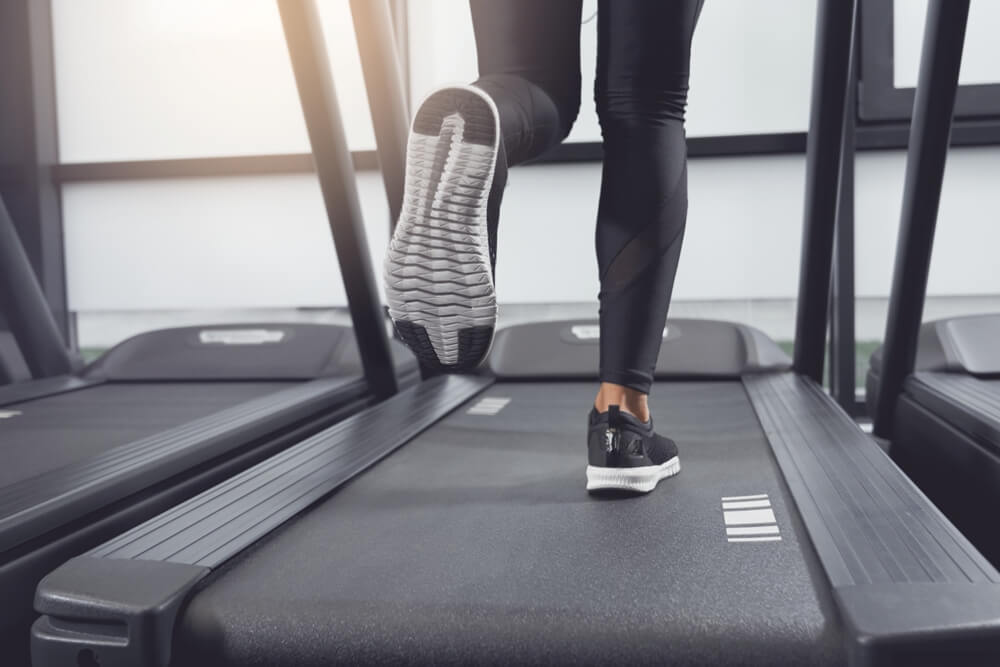A treadmill is a device used for walking or running while staying in the same place. It has become one of the most popular pieces of exercise equipment in many homes and fitness centers. The treadmill offers several benefits, including a better cardiovascular system, greater endurance, and stronger muscles. We’ll look at how to use your treadmill for maximum effect!
What is a treadmill?
A treadmill is a type of stationary equipment regarded as the most beneficial indoor exercise equipment. Modern treadmills have automatic tilt, adjustable speed, heart rate monitoring, and slope adjustments. A treadmill is a beautiful piece of equipment for runners. Treadmills are excellent for toning muscles and improving cardiovascular performance, which can also help you burn more calories. A treadmill is suitable for everyone, regardless of their fitness level.
Read More: Best Treadmills Under $2000
What Muscles Does the Treadmill Work On?
The treadmill is a great way to work on your leg muscles, especially your quads (the large muscles on the front of your thighs). When you walk or run on an incline, you also work your glutes (butt) and hamstrings (back of your thigh). If you add hand weights to your routine, you can also work your arms. Treadmills are a great way to get a full-body workout!
Muscle Group Worked by Treadmill
Treadmills are mostly used for lower-body exercises such as walking, running, and jogging. However, they can also be used for upper-body muscles by holding on to the handrails. This equipment works multiple muscle groups in your body, including the following:
The muscles in our body are organized into different groups, and each group is connected to a specific joint. The muscles surround the bones and assist in the movement of that joint to which they belong. When we exercise, our muscles must work. For example, when we walk, run, or perform physical activity on the lower part of our body, our muscles below are employed. The core is also engaged when walking or running on an incline mode treadmill. Also, don’t forget about the boneless one, the cardiac muscle, which is the most essential since it’s responsible for keeping our hearts beating. Walking, jogging, running, or interval training are the best physical activities based on physical strength, need, or ability.
Let’s take a look at the muscles that are activated while working out on a treadmill:
Hamstrings
These are the muscles located at the back of your thighs. This is made of three muscles- the biceps femoris, semitendinosus, and semimembranosus. These muscles are responsible for hip extension and knee flexion.
The hamstrings assist athletes and people who participate in sports by providing additional power to their muscles. Exercising your hamstrings regularly will improve your running endurance and make your activities more efficient and fun. Exercising your hamstrings daily won’t feel any discomfort since these muscles will grow stronger and harder over time.

Quadriceps
Quadriceps are a large muscle group on your thigh extending to the knee. It comprises four muscles- the rectus femoris, vastus medialis, vastus lateralis, and intermedius. All of these muscles are responsible for knee extension.
The quadriceps help in walking, jogging, climbing stairs, and lifting objects. These muscles also provide power to your legs when you kick a ball or jump. If you exercise your quadriceps regularly, you will improve your leg strength and reduce the risk of knee injuries. While running or walking, these muscles are certainly engaged too.
Walking on an incline slowly in a backward direction engages your quads more effectively. During exercise, your body’s quads continuously work and do most of the work when you walk or run.
Walking on the treadmill activates the quadriceps and makes them firm and hard. With the correct diet, the fat that collects there will dissolve away and be absorbed by your muscle.
Calves
This is a significant muscle group for athletes and sports enthusiasts. They understand the importance of having calf strengths. The gastrocnemius and soleus muscles make up this group from knee to ankle.
The calf muscles are very important in our day-to-day activities. For example, the muscles in our calf help us push off the ground and move forward when we walk or run. If you exercise your calves regularly, you will improve your leg strength and reduce the risk. Athletes focus on tightening their calf muscles and enhancing their stride when running or playing sports. Furthermore, fitness freaks, and people who exercise regularly build up their calf muscles as it takes their workout to a new level.
This is straightforward on a treadmill. Walking on an incline with your treadmill set at a low speed activates the gastrocnemius muscle, which improves them if done regularly.
Glutes or Gluteus Muscles
When you walk up an incline on a treadmill, your glutes are emphasized and hit. Your glutes are made up of four muscles: Gluteus Maximus, Medius, Minimus, and Maximus.
Treadmills engage muscles are engaged when you walk or run on them. A treadmill is required for those who want to build up their glute muscles. Walking on an incline puts pressure on the lower back, including the glutes, so carefully choosing your walking route is important.
Treadmills are ideal for toning and rounding your behind, as they allow you to work out in a low-impact manner. Walking lunges and squats can be done while walking on a treadmill, which is good since many muscle groups may be targeted. However, be careful to adjust the speed of your treadmill to a slow pace and grasp.
Core Muscles
Your core muscles include your abs and your obliques. They are critical to maintaining a trim, attractive physique. They maintain your body’s stability and equilibrium while also protecting the spine. Who doesn’t want a strong, flat core? And the good news is that a treadmill can help you get there!
When you walk or run on a treadmill, your core muscles are activated, keeping you upright and stabilizing your pelvis. Your transverse abdominal muscle also strains to force air from your lungs as your breathing quickens.
These muscles are worked harder due to the greater effort you put into your treadmill exercise, especially if you run on an elevated slope.
You can do a few things to make your core workout more effective on a treadmill: Stand upright with your shoulders, back and head up; this allows your core muscles to function effectively by keeping everything straight.
Breathe deeply:
Engaging your core while breathing through your nose and out through your mouth will contract your abs. Your core muscles will function as a result of this.

Heart
Your heart is your most important muscle. Cardiac muscle makes up the unique muscular tissue that comprises your heart. It conveys blood and oxygen to all of your other muscles and body organ so that they may continue to function properly. What could be more vital than this? A strong heart also helps to increase your endurance and lowers the risk of many deadly illnesses such as heart disease. A healthy heart is critical for healthy existence. Keep your heart in great shape with treadmill exercises! Isn’t it wonderful?
Here are some tips for getting the most out of the treadmill for your cardiovascular system:
Upper body movement:
It will raise your heart rate and promote the burning of more calories. Swinging your arms, for example, is a popular upper-body exercise.
Interval training:
This is one of the most efficient treadmill exercises. Perhaps the finest treadmill workout? You may run fast for a minute, at a speed as high as possible, and then walk for two minutes before repeating this procedure. Alternatively, you may raise and lower the incline.
Interval training is beneficial to your heart and helps you develop stronger muscles, burn calories, and reduce weight. As a result, this type of exercise is excellent for your overall health.
How to Use the Treadmill for Maximum Effect
To get the most out of your treadmill workout, it is important to warm up before you start. A light jogs or walk for five to ten minutes will prepare your muscles for a more intense workout. It is also important to cool down after your workout by reducing your speed and gradually coming to a stop. Cooling down helps your body recover from strenuous exercise and prevents injuries.
Here are some tips on how to use the treadmill for maximum effect:
- Start slowly and gradually increase your speed as you warm up.
- Don’t forget to cool down when you’re finished by walking at a slower pace for a few minutes.
- If you want to increase the intensity of your workout, try adding an incline.
- Interval training is also a great way to make your treadmill workout more effective. For example, you can alternate between one minute of running and one minute of walking.
Precautions
Before starting any new exercise routine, it is always good to check with your doctor first, especially if you have any health concerns. If you are new to exercise, it is also a good idea to start slow and gradually increase the intensity of your workouts. While treadmills are generally safe, there is always a risk of injury when using exercise equipment. Here are some precautions to take when using a treadmill:
- Start slowly and gradually increase your speed and intensity.
- Wear comfortable, supportive shoes that are designed for walking or running.
- Don’t hold on to the handrails too tightly. This can cause you to lean too far forward and lose your balance.
- Pay attention to your form.
- Remember to stay hydrated during your workout by drinking plenty of water.
Summary: What Muscles Does a Treadmill Work?
The treadmill is a great way to work the lower body muscles, including the quadriceps, hamstrings, and calves. When you walk or run on a treadmill, you use these muscles to move your legs and keep your balance. The incline feature of many treadmills can also be used to target different muscle groups. For example, walking on an incline can help to tone the buttocks and thighs.
To get the most out of your treadmill workouts, warm-up before you start and cool down after you finish. A good warm-up will increase your heart rate and prepare your muscles for exercise. A cool-down will help your body recover from the workout and reduce the risk of injury.
Most importantly, listen to your body and stop if you feel pain or discomfort. Treadmill workouts can be intense, so it is important to take breaks as needed. Consult your doctor before starting a new exercise program if you have any medical conditions.
Now that you know more about the muscle group worked by the treadmill, get out there and start your workout! Remember to warm up, cool down, and listen to your body to stay safe and healthy.
And have fun!




